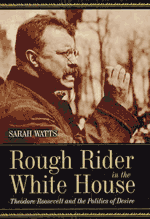Cowboys and Presidents

What did Presidents Theodore Roosevelt and Richard Nixon have in common? They both loved the Wild West.
Roosevelt, a native New Yorker, molded himself into a cowboy. In his twenties, he worked as a cattle rancher in the Dakotas. He spent thirteen-hour days in the saddle, breaking in wild cow ponies, and fighting off cattle thieves and roaming gangs. Why did he do this?
According to Sarah Watts, author of Rough Rider in the White House: Theodore Roosevelt and the Politics of Desire,
[Roosevelt] sensed that ordinary men needed a clearly recognizable and easily appropriated hero who enacted themes about the body; the need for extremity, pain, and sacrifice; and the desire to exclude some men and bond with others. In one seamless cowboy-soldier-statesman-hero life, Roosevelt crafted the cowboy ethos consciously and lived it zealously, providing men an image and a fantasy enlisted in service to the race-nation.
Nixon, it turns out, was the type of man who believed in such heroes. Mark Feeney, author of Nixon at the Movies: A Book about Belief, writes that Nixon screened fifty-six Westerns during his five year tenure in office. Twenty of these Westerns were directed by John Ford. In an interview on NPR last year, Feeney speculated that the reason why Nixon liked Ford’s movies was because of their "consistent theme of community.… Nixon was such a lonely and isolated person and in the movies you can be lonely and isolated and not feel the pressure of that."
Read Cowboy Soldiers, an excerpt from Rough Rider in the White House.
Read the appendix from Nixon at the Movies, which lists all films screened by Nixon during his presidency.